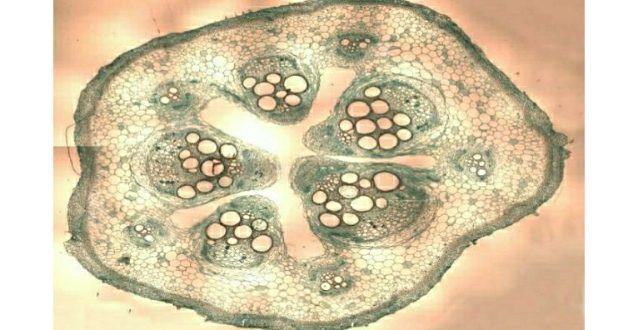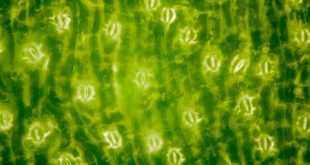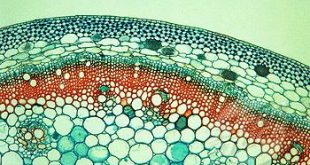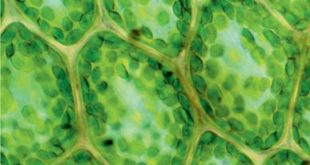Anomalous secondary growth” is the term under which have been grouped cambial conformations, cambial products, and cambial numbers which differ from the most common “normal” condition, namely, a single cylindrical cambium that produces phloem externally and xylem internally.
In this article, Anomalous secondary growth, it’s causes and position will be discussed briefly.
Anomalous Secondary Growth
Several dicotyledons show secondary growth that is different from normal secondary growth. The deviating methods of secondary thickening are called abnormal or anomalous secondary growth. In dicot stem anomalous secondary growth occurs due to following reasons:
- Anomalous position of cambium
- Accessory cambium formation and its activities
- Abnormal behavior of normal cambium
- Extrastelar cambium formation
- Interxylary phloem or included phloem
These are described as follows:
1. Anomalous position of cambium
In this case, the position of cambium is anomalous but the activity of cambium is normal. e.g. Serjania sp. Here secondary growth occurs due to the anomalous position of cambium. A very peculiar structure is noticed in Serjania, a climber of family Sapindaceae, where the cambium from the very beginning occurs in separate strips, each strip having primary xylem towards the center and primary phloem towards the periphery. It thus appears like a deeply-lobed compound structure made of several stems fused together. With age and consequent development of periderm the compound structure becomes more marked. The development of interfascicular cambium and its union with fascicular ones result in the formation of separate cambium rings. In fact, there is a large central stele, surrounded by a few peripheral ones.
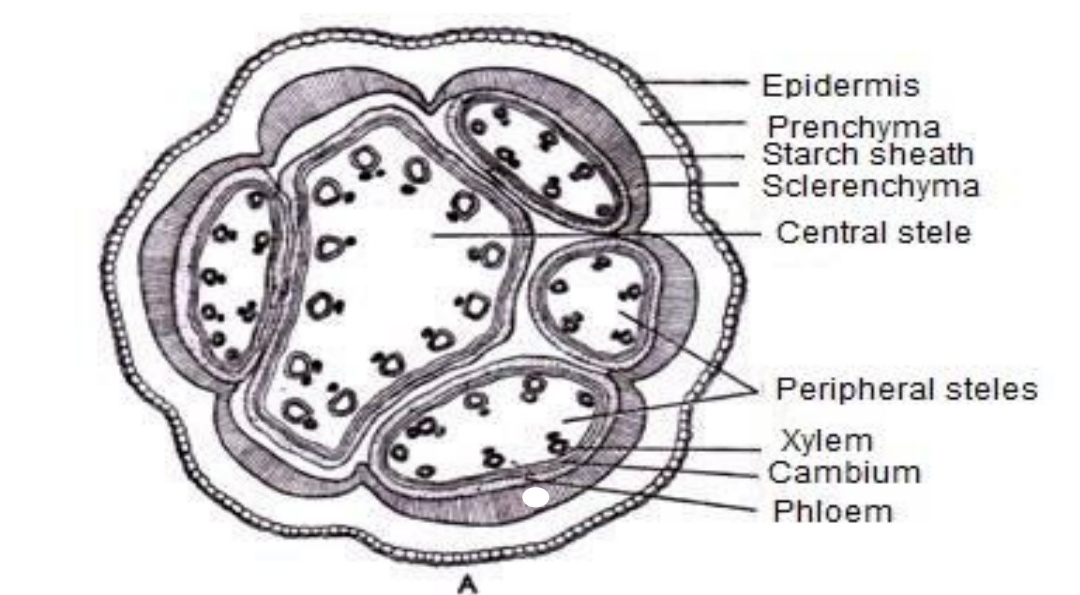
2. Accessory cambium formation and its activity
- In the stem of Baugainvillea and others member of the Nyctaginaceae (e.g., Boerhaavia, Mirabilis etc.) several cambia arise successively in a centrifugal direction. Each cambium produces xylem and conjunctive tissue to the inside and phloem and conjunctive tissue to the outside. The resulting tissue gives the appearance of concentric ring of vascular bundle embedded in conjunctive tissue.
- The TS of Boerhaavia diffusa show two medullary bundles, a middle ring of 6-10 vascular bundle and another ring of 15-20 or more small bundle. The bundle of the middle ring increase in thickness to a limited extent by a fascicular cambium. The bundle of the outer ring are initially separate, quite small and each provided with its own fascicular cambium. The fascicular cambium of the bundle becomes interconnected by interfascicular cambium.
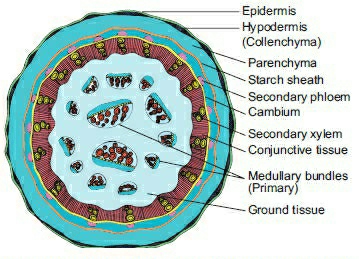
3. Abnormal behavior of normal cambium
Sometimes when the normal cambium starts to cutting cell at several places irregularly and forms at certain places much larger portion of xylem and a ridge and furrowed xylem cylinder produced. This may be of simple structure or very complex. e.g. Bignonia sp.
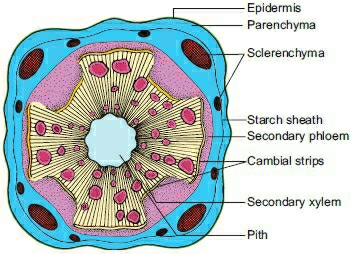
4. Extra-stelar cambium formation
Medullary vascular bundle present. Medullary vascular bundle which are many and scattered in the pith. Bundles are open and collateral. Cambial activity is only found in individual bundle. The cambial activity ceases in this bundle. Anomalous secondary growth takes place due to the development of a new extra-stelar cambium formation outside the stele in the pericycle region. Cambium cuts off secondary vascular bundle and interfascicular parenchymatous conjunctive tissue on the inner side. e.g. Amaranthus sp.
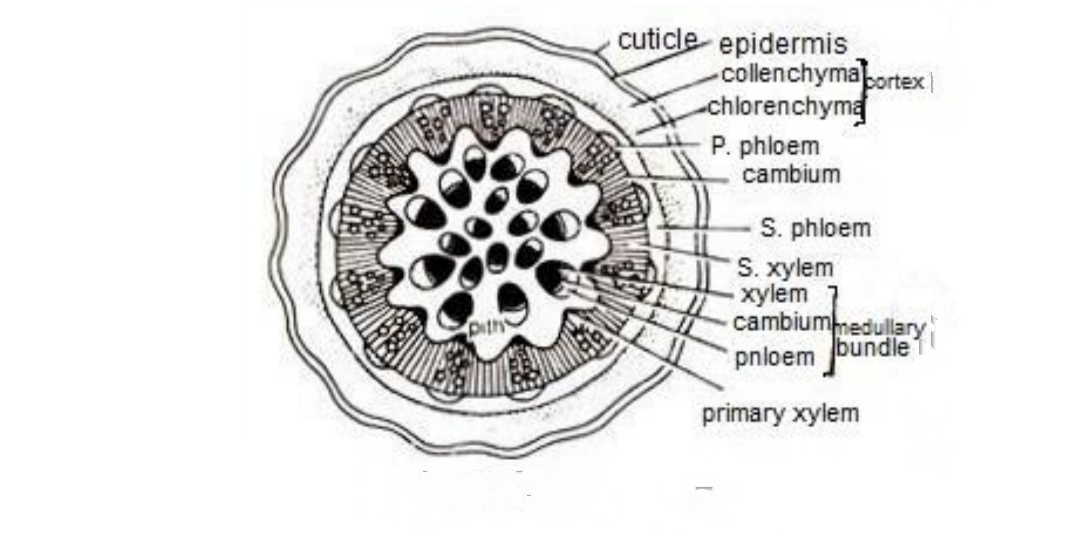
5. Interxylary phloem or included phloem
Interxylary phloem is defined as strands or bands of phloem embedded within the secondary xylem of a stem of a plant. Anomalous secondary growth occurs due to the anomalous activity of cambium. Some parts of cambium ring is identified as cambial strip. This cambial strip produce secondary phloem instead of secondary xylem on the inner side. Due to this anomalous activities of cambial strip secondary phloem embedded in the secondary xylem. Then cambium produce secondary xylem on the inner side. The presence of phloem strands embedded within the secondary xylem is called inter-xylary phloem or included phloem. e.g. Entada sp, Combretum sp, Strychnos sp.
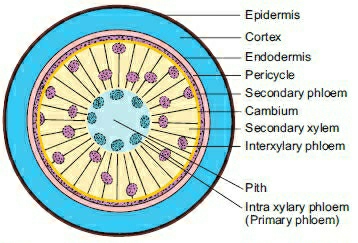
Anomalous Secondary growth in monocot stem
Secondary growth occurs in herbaceous woody liliflorae (Aloe, Agave). In Dracaena and other groups of monocot (Cheadle 1937), the meristem concerned with this growth is called cambium. The cambium originates in the parenchyma outside the vascular bundles. This part is identified as cortex.
Dracaena shows anomalous secondary growth where the cambium appears in the parenchyma cells outside the vascular bundle. This region in which cambium appears identify as cortex. These newly formed cuts cells towards outside and inside both. The tissue develops in the inner side of
the cambium is differentiated into secondary vascular bundle remain separated by each other by lignified cell.
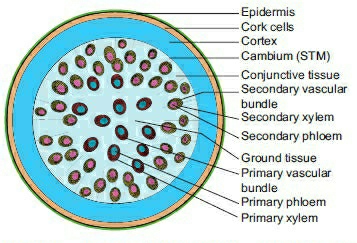
Reference:
1. Class Lecture of Parveen Rashid, PhD
Professor, Department of Botany, University of Dhaka.
 Plantlet The Blogging Platform of Department of Botany, University of Dhaka
Plantlet The Blogging Platform of Department of Botany, University of Dhaka
